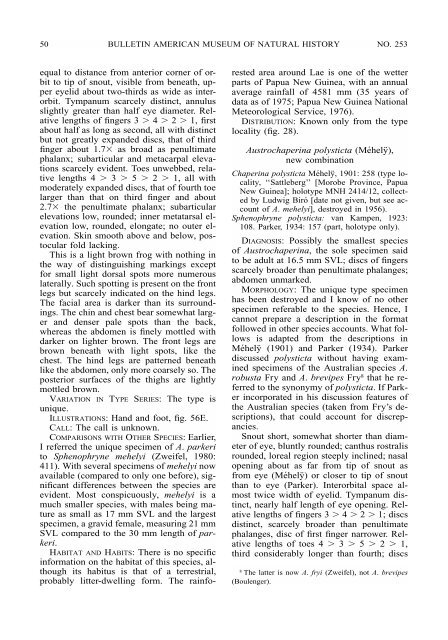SPHENOPHRYNE - American Museum of Natural History
SPHENOPHRYNE - American Museum of Natural History
SPHENOPHRYNE - American Museum of Natural History
Create successful ePaper yourself
Turn your PDF publications into a flip-book with our unique Google optimized e-Paper software.
50 BULLETIN AMERICAN MUSEUM OF NATURAL HISTORY NO. 253<br />
equal to distance from anterior corner <strong>of</strong> orbit<br />
to tip <strong>of</strong> snout, visible from beneath, upper<br />
eyelid about two-thirds as wide as interorbit.<br />
Tympanum scarcely distinct, annulus<br />
slightly greater than half eye diameter. Relative<br />
lengths <strong>of</strong> fingers 3 4 2 1, first<br />
about half as long as second, all with distinct<br />
but not greatly expanded discs, that <strong>of</strong> third<br />
finger about 1.7 as broad as penultimate<br />
phalanx; subarticular and metacarpal elevations<br />
scarcely evident. Toes unwebbed, relative<br />
lengths 4 3 5 2 1, all with<br />
moderately expanded discs, that <strong>of</strong> fourth toe<br />
larger than that on third finger and about<br />
2.7 the penultimate phalanx; subarticular<br />
elevations low, rounded; inner metatarsal elevation<br />
low, rounded, elongate; no outer elevation.<br />
Skin smooth above and below, postocular<br />
fold lacking.<br />
This is a light brown frog with nothing in<br />
the way <strong>of</strong> distinguishing markings except<br />
for small light dorsal spots more numerous<br />
laterally. Such spotting is present on the front<br />
legs but scarcely indicated on the hind legs.<br />
The facial area is darker than its surroundings.<br />
The chin and chest bear somewhat larger<br />
and denser pale spots than the back,<br />
whereas the abdomen is finely mottled with<br />
darker on lighter brown. The front legs are<br />
brown beneath with light spots, like the<br />
chest. The hind legs are patterned beneath<br />
like the abdomen, only more coarsely so. The<br />
posterior surfaces <strong>of</strong> the thighs are lightly<br />
mottled brown.<br />
VARIATION IN TYPE SERIES: The type is<br />
unique.<br />
ILLUSTRATIONS: Hand and foot, fig. 56E.<br />
CALL: The call is unknown.<br />
COMPARISONS WITH OTHER SPECIES: Earlier,<br />
I referred the unique specimen <strong>of</strong> A. parkeri<br />
to Sphenophryne mehelyi (Zweifel, 1980:<br />
411). With several specimens <strong>of</strong> mehelyi now<br />
available (compared to only one before), significant<br />
differences between the species are<br />
evident. Most conspicuously, mehelyi is a<br />
much smaller species, with males being mature<br />
as small as 17 mm SVL and the largest<br />
specimen, a gravid female, measuring 21 mm<br />
SVL compared to the 30 mm length <strong>of</strong> parkeri.<br />
HABITAT AND HABITS: There is no specific<br />
information on the habitat <strong>of</strong> this species, although<br />
its habitus is that <strong>of</strong> a terrestrial,<br />
probably litter-dwelling form. The rainfo-<br />
rested area around Lae is one <strong>of</strong> the wetter<br />
parts <strong>of</strong> Papua New Guinea, with an annual<br />
average rainfall <strong>of</strong> 4581 mm (35 years <strong>of</strong><br />
data as <strong>of</strong> 1975; Papua New Guinea National<br />
Meteorological Service, 1976).<br />
DISTRIBUTION: Known only from the type<br />
locality (fig. 28).<br />
Austrochaperina polysticta (Méhely¨),<br />
new combination<br />
Chaperina polysticta Méhely¨, 1901: 258 (type locality,<br />
‘‘Sattleberg’’ [Morobe Province, Papua<br />
New Guinea]; holotype MNH 2414/12, collected<br />
by Ludwig Biró [date not given, but see account<br />
<strong>of</strong> A. mehelyi], destroyed in 1956).<br />
Sphenophryne polysticta: van Kampen, 1923:<br />
108. Parker, 1934: 157 (part, holotype only).<br />
DIAGNOSIS: Possibly the smallest species<br />
<strong>of</strong> Austrochaperina, the sole specimen said<br />
to be adult at 16.5 mm SVL; discs <strong>of</strong> fingers<br />
scarcely broader than penultimate phalanges;<br />
abdomen unmarked.<br />
MORPHOLOGY: The unique type specimen<br />
has been destroyed and I know <strong>of</strong> no other<br />
specimen referable to the species. Hence, I<br />
cannot prepare a description in the format<br />
followed in other species accounts. What follows<br />
is adapted from the descriptions in<br />
Méhely¨ (1901) and Parker (1934). Parker<br />
discussed polysticta without having examined<br />
specimens <strong>of</strong> the Australian species A.<br />
robusta Fry and A. brevipes Fry8 that he referred<br />
to the synonymy <strong>of</strong> polysticta. If Parker<br />
incorporated in his discussion features <strong>of</strong><br />
the Australian species (taken from Fry’s descriptions),<br />
that could account for discrepancies.<br />
Snout short, somewhat shorter than diameter<br />
<strong>of</strong> eye, bluntly rounded; canthus rostralis<br />
rounded, loreal region steeply inclined; nasal<br />
opening about as far from tip <strong>of</strong> snout as<br />
from eye (Méhely¨) or closer to tip <strong>of</strong> snout<br />
than to eye (Parker). Interorbital space almost<br />
twice width <strong>of</strong> eyelid. Tympanum distinct,<br />
nearly half length <strong>of</strong> eye opening. Relative<br />
lengths <strong>of</strong> fingers 3 4 2 1; discs<br />
distinct, scarcely broader than penultimate<br />
phalanges, disc <strong>of</strong> first finger narrower. Relative<br />
lengths <strong>of</strong> toes 4 3 5 2 1,<br />
third considerably longer than fourth; discs<br />
8 The latter is now A. fryi (Zweifel), not A. brevipes<br />
(Boulenger).
















